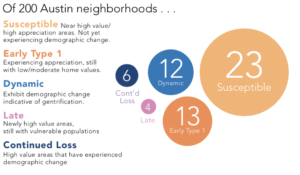Gentrification is rapidly reshaping many cities across the United States, including Texas, displacing vulnerable residents and changing the cultural character of communities.
What is Gentrification?
Gentrification is a process of neighborhood change where higher-income and higher-educated residents move into a historically marginalized neighborhood, housing costs rise, and the neighborhood is physically transformed through new higher-end construction and building upgrades, resulting in the displacement of vulnerable residents and changes to the neighborhood’s cultural character.
A core driver of gentrification in the U.S. has been the strong and growing demand for central city living by more affluent households, which in turn drives up housing prices in central city neighborhoods. This broad-scale demographic shift is actively underway in many Texas cities, including Houston, Austin, and Dallas. City planning, economic development initiatives, and tax incentives fostering redevelopment in central neighborhoods are considered to be additional factors influencing gentrification.
Neighborhoods impacted by gentrification have been shaped historically by decades of discriminatory public policies and private real estate practices that undermined property values, facilitated substandard living conditions, and generated racially segregated housing patterns. These neighborhoods’ lower property values, location in the urban core near good jobs and transit, and historical and cultural character are all factors that are making them more attractive to newcomers and susceptible to redevelopment.
Understanding Displacement
There are several types of displacement that can occur in gentrifying neighborhoods:
Direct displacement occurs when residents can no longer afford to remain in their homes due to rising housing costs. Residents may also be forced out by lease non-renewals, evictions, eminent domain, or physical conditions that render homes uninhabitable as investors await redevelopment opportunities. While displacement occurs routinely in low-income neighborhoods, when it occurs in the context of new development and an influx of wealthier residents, the displacement becomes a characteristic of gentrification.
Indirect displacement refers to changes in who is moving into a neighborhood as low-income residents move out. In a gentrifying neighborhood, when homes are vacated by low-income residents, other low-income residents cannot afford to move in because rents and sales prices have increased. This is also called exclusionary displacement. Low-income residents can also be excluded as a result of discriminatory policies (for example, a ban on tenants with housing vouchers) or changes in land use or zoning that foster a change in the character of residential development, such as eliminating units for households without children.
Cultural displacement occurs as the scale of residential change advances. Shops and services shift to focus on new residents, the character of the neighborhood is transformed, and the remaining residents may feel a sense of dislocation despite remaining in the neighborhood.
When understood as a process rooted in the uneven treatment of particular neighborhoods and racial and ethnic groups, addressing gentrification-induced displacement requires attention to former residents who have already been displaced, current residents, and future residents. Some cities have created “right of return” or preference policies that focus on former residents or those at risk of being displaced. At the same time, it is important to ensure that in the future other low-income persons and persons of color will also be able to access the opportunities in gentrifying neighborhoods and that the scale of change does not erase key aspects of neighborhoods that allow both current and future residents to feel at home.
Who Is Impacted by Gentrification and Displacement?
As communities seek to craft tools for reducing displacement in gentrifying neighborhoods, it’s important to first identify which neighborhoods in the city are already gentrifying or are susceptible to gentrifying, as well as the groups of residents in those neighborhoods who are most vulnerable to displacement in the face of rising housing costs. Cities can then more effectively tailor their tools to address the needs of those neighborhoods and residents. For example, many tools to address gentrification are more effective in neighborhoods in the earlier stages of gentrifying, while other tools are more viable in the later stages. And some tools are more effective in addressing the displacement of renters, while others are more effective in addressing the displacement of homeowners.
When cities create economic development projects and implement major public infrastructure projects, understanding a neighborhood’s vulnerability to displacement also helps a city recognize when to incorporate displacement mitigation strategies up front into those projects, rather than waiting until later. Once gentrification picks up steam, reducing displacement becomes much more difficult.
A number of methodologies are available for analyzing which neighborhoods are gentrifying and the level of gentrification occurring, as well as which neighborhoods are at the greatest risk of gentrifying. The analysis for the City of Austin by faculty from The University of Texas at Austin (https://sites.utexas. edu/gentrificationproject/) built upon a methodology developed by Professor Lisa Bates at Portland State University. The City of Denver’s gentrification analysis also built off of Professor Bates’ methodology. The gentrification analysis for the cities of Minneapolis and St. Paul combined three different methodologies, including Bates’ methodology. The Urban Displacement Center has also developed a useful methodology that has been used in many cities.
As for identifying groups of residents who are most vulnerable to displacement in gentrifying neighborhoods, there are five primary indicators of vulnerability. Renters, low-income households, persons of color, households headed by a resident without a college degree, and families with children in poverty are, overall, more vulnerable to displacement from rising housing costs than other groups of residents.


